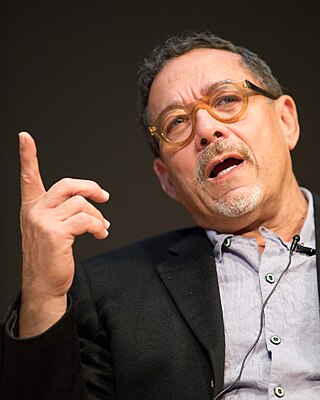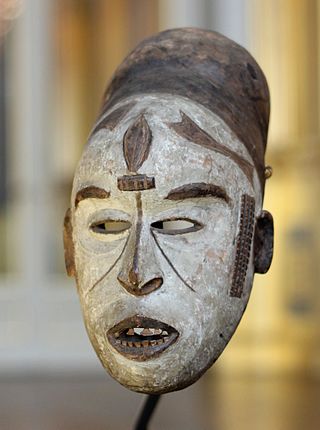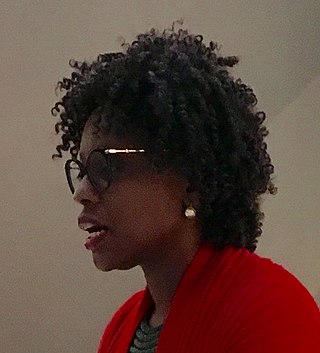Related Research Articles

The Kingdom of Dahomey was a West African kingdom located within present-day Benin that existed from approximately 1600 until 1904. It developed on the Abomey Plateau amongst the Fon people in the early 17th century and became a regional power in the 18th century by expanding south to conquer key cities like Whydah belonging to the Kingdom of Whydah on the Atlantic coast which granted it unhindered access to the tricontinental Atlantic Slave Trade.

Vodun is a religion practiced by the Aja, Ewe, and Fon peoples of Benin, Togo, Ghana, and Nigeria.

The Fon people, also called Fon nu, Agadja or Dahomeans, are a Gbe ethnic group. They are the largest ethnic group in Benin found particularly in its south region; they are also found in southwest Nigeria and Togo. Their total population is estimated to be about 3,500,000 people, and they speak the Fon language, a member of the Gbe languages.

Ouidah or Whydah, and known locally as Glexwe, formerly the chief port of the Kingdom of Whydah, is a city on the coast of the Republic of Benin. The commune covers an area of 364 km2 (141 sq mi) and as of 2002 had a population of 76,555 people.

Mami Wata is a water spirit venerated in West, Central, and Southern Africa and in the Afro-American diaspora. Mami Wata spirits are usually female but are sometimes male.

Edouard Duval-Carrié is a Haitian-born American contemporary painter and sculptor based in Miami, Florida.
Calixte Dakpogan is a Beninese sculptor known for his installations as well as his masks made out of diverse and original found materials. A native of Pahou, he currently lives and works in Porto Novo. Much of his work is inspired by his Voudon heritage.

Francisco Félix de Souza was a Brazilian slave trader who was deeply influential in the regional politics of pre-colonial West Africa. He founded Afro-Brazilian communities in areas that are now part of those countries, and went on to become the "chachá" of Ouidah, a title that conferred no official powers but commanded local respect in the Kingdom of Dahomey, where, after being jailed by King Adandozan of Dahomey, he helped Ghezo ascend the throne in a coup d'état. He became chacha to the new king, a curious phrase that has been explained as originating from his saying "(...) já, já.", a Portuguese phrase meaning something will be done right away.

Manuel Mendive Hoyos is an Afro-Cuban artist.
Cyprien Tokoudagba was a Beninese sculptor and painter. He was from Abomey, Benin.

Some African objects had been collected by Europeans for centuries, and there had been industries producing some types, especially carvings in ivory, for European markets in some coastal regions. Between 1890 and 1918 the volume of objects greatly increased as Western colonial expansion in Africa led to the removal of many pieces of sub-Saharan African art that were subsequently brought to Europe and displayed. These objects entered the collections of natural history museums, art museums and private collections in Europe and the United States. About 90% of Africa's cultural heritage is believed to be located in Europe, according to French art historians.
Julien Sinzogan, is a Beninese contemporary painter and graphic artist. His artwork actively engages the impact of the Atlantic Slave Trade on his native Benin, one of the largest slave-trading posts of West Africa. He has exhibited widely throughout Europe and Africa. As a professional artist Sinzogan's techniques and references move from areas of monochrome pen and ink into glimpses of full-color scenes. He lives in Paris, France.

Vodun art is associated with the West African Vodun religion of Nigeria, Benin, Togo and Ghana. The term is sometimes used more generally for art associated with related religions of West and Central Africa and of the African diaspora in Brazil, the Caribbean and the United States. Art forms include bocio, carved wooden statues that represent supernatural beings and may be activated through various ritual steps, and Asen, metal objects that attract spirits of the dead or other spirits and give them a temporary resting place. Vodun is assimilative, and has absorbed concepts and images from other parts of Africa, India, Europe and the Americas. Chromolithographs representing Indian deities have become identified with traditional Vodun deities and used as the basis for murals in Vodun temples. The Ouidah '92 festival, held in Benin in 1993, celebrated the removal of restrictions on Vodun in that country and began a revival of Vodun art.
The International Festival of Vodun Arts and Cultures, also known as the Ouidah Festival, was first held in Ouidah, Benin in February 1993, sponsored by UNESCO and the government of Benin. It celebrated the transatlantic Vodun religion, and was attended by priest and priestesses from Haiti, Cuba, Trinidad and Tobago, Brazil and the United States, as well as by government officials and tourists from Europe and the Americas. The festival was sponsored by the newly elected president of Benin, Nicéphore Soglo, who wanted to rebuild the connection with the Americas and celebrate the restoration of freedom of religion with the return to democracy. Artists from Benin, Haiti, Brazil and Cuba were given commissions to make sculptures and paintings related to Vodun and its variants in Africa and the African diaspora.
Simonet Biokou is a contemporary Beninese scrap metal artist. He has also appeared in film, playing himself in the 1998 film Divine Carcasse, in which his character is shown creating a sculpture using car parts. His works have been featured in major metropolitan museums including the Metropolitan Museum in New York.
Yves Apollinaire Pede (1959–2019) was a Beninese voodoo artist. After being commissioned to reproduce reliefs for the Abomey Museum, he made sand paintings of well-known personalities such as Nelson Mandela. He gradually became oriented towards textile art, looking to Haitian and Cuban Vodou artists for inspiration. He is also noted for his large cement sculptures and bas-reliefs, and is stated to have a "special interest" in Kulito, a Fon word which literally means "the one from the path of death".
Joseph Kossivi Ahiator is an African politician and Ghanaian artist known for his temple mural paintings in Bénin, Ghana, and Togo. He is a member of the National Democratic Congress (NDC) and a former Member of Parliament for the Ketu South Constituency in the Volta Region of Ghana.

Ato Malinda, also known as Alex Mawimbi is a multidisciplinary performance artist.

The Door of No Return is a memorial arch in Ouidah, Benin. The concrete and bronze arch, which stands on the beach, is a memorial to the enslaved Africans who were taken from the slave port of Ouidah to the Americas.
Jean-Dominique Burton, born on 13 October 1952 in Huy (Belgium), is a Belgian photographer and filmmaker, author of several books of photographs focusing on Europe, Asia and Africa. Since 1978, numerous exhibitions have been dedicated to his work, in Europe, Africa, North America and Asia. Many of his works have also been included in public and private collections.
References
- ↑ Revue noire. Publications Editions Bleu Outremer. 1995. pp. 13–4, 18.
- ↑ Rush, Dana. "Contemporary Vodun Arts of Benin". academia.edu. UCLa James S. Coleman African Studies Center. Retrieved 1 November 2023.
- ↑ African Arts. African Studies Center, University of California, Los Angeles. 2001. p. 36.
- ↑ Silverman, Helaine (2 November 2010). Contested Cultural Heritage: Religion, Nationalism, Erasure, and Exclusion in a Global World. Springer Science & Business Media. p. 214. ISBN 978-1-4419-7305-4.
- ↑ Jagoe, Rebecca (21 June 2013). "Contemporary Art in Benin: A History in Ten Artists". Culture Trip. Retrieved 2020-10-02.
- ↑ Gupta, Atreyee; Rodatus, Verena. "Cyprien Tokoudagba and Dominique Kouas: Querying the Place of the 'Vernacular' in Contemporary Béninois Visual Arts". Medium. Traditional to Contemporary Aesthetic Practices in West Africa, Benin and Togo. Retrieved 1 November 2023.
- ↑ Drewal, H. J. (2008). Mami Wata: Arts for Water Spirits in Africa and Its Diasporas. African Arts, 41(2), 60–83. http://www.jstor.org/stable/20447886
- ↑ Helaine Silverman pg.213. http://ndl.ethernet.edu.et/bitstream/123456789/15813/1/64.pdf DOI 10.1007/978-1-4419-7305-4_1,
- ↑ Xuereb Seidu, Christine. "From Restitution to Revelation". artpaper. Retrieved 1 November 2023.
- ↑ https://www.slaverymonuments.org/items/show/1147
- ↑ DAYS, VODUN. "The historical city of Ouidah to host Vodun Days on january 9 and 10, 2024". Ecofin Agency.
- ↑ "October Gallery". October Gallery.
- ↑ "Dominique Kouas – JNGFA".